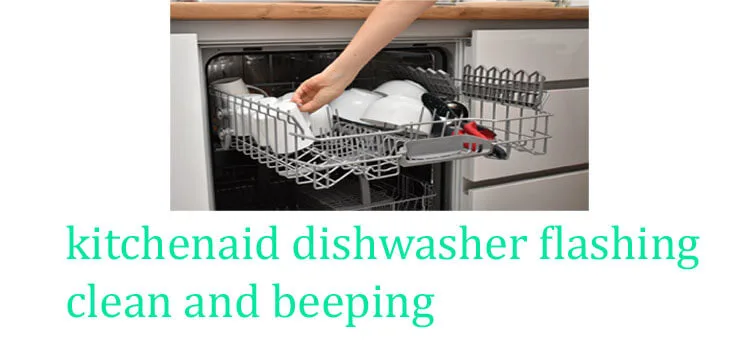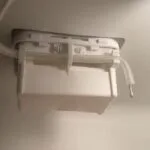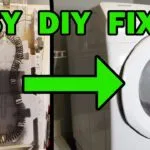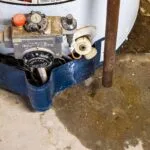If your Kitchenaid dishwasher is flashing clean and beeping, it may indicate a problem with the heating element or the thermostat. To troubleshoot, try resetting the dishwasher by unplugging it or turning off the circuit breaker for a few minutes.
If the issue persists, check the heating element and thermostat for any damage, and replace them if necessary. A Kitchenaid dishwasher is an efficient and convenient appliance designed to make your life easier. However, issues like flashing and beeping can be frustrating and disruptive to your routine.
In this article, we’ll discuss some common reasons why your KitchenAid dishwasher may be flashing clean and beeping, as well as some tips for troubleshooting and resolving the issue. By following these steps, you can get your dishwasher back up and running in no time.

Why Is Your Kitchenaid Dishwasher Flashing Clean?
Stop The Annoying Beeps: Fix Your Kitchenaid Dishwasher Flashing Clean
You’ve just finished dinner and loaded your Kitchenaid dishwasher for a thorough clean. But as soon as you press the start button, you notice your dishwasher is flashing clean and beeping continuously. What does it mean? How can you fix this frustrating issue?
In this blog post, we’ll explain the common reasons why the dishwasher keeps flashing clean and how to fix it effectively.
Explain The Common Reasons Why The Dishwasher Keeps Flashing Clean.
Identifying the underlying issue is key to preventing annoying beeps and ensuring your KitchenAid dishwasher works efficiently. Below are common reasons why you may experience flashing issues.
- Clogged drain: A clogged dishwasher drain can cause water backup, resulting in the flashing clean issue. Check your dishwasher’s drain to ensure there are no food particles or blockages.
- Dirty filters: The dishwasher’s filters protect the drain from becoming clogged with food particles. When these filters are dirty or clogged, your dishwasher may not function properly, leading to the flashing clean problem.
- Malfunctioned heating element: The dishwasher’s heating element plays a vital role in cleaning and drying dishes. If the heating element isn’t functioning, the dishwasher may flash clean.
- The dishwasher needs resetting: At times, resetting your Kitchenaid dishwasher may solve the flashing clean issue. This can be done by unplugging the dishwasher for a few minutes or pressing certain combinations of buttons to reset the machine.
Mention The Importance Of Identifying The Underlying Issue To Fix It Effectively.
Fixing your Kitchenaid dishwasher’s flashing clean issue depends on identifying the root problem. A reliable solution cannot be implemented until you know the cause of the problem. For instance, if dirty filters are the issue, you must clean or replace them to ensure your dishwasher functions correctly.
On the other hand, if a malfunctioning heating element is a problem, only a professional repair service can help you fix it. Identifying the underlying issue not only allows you to solve the current flashing clean issue, but it also helps you prevent future malfunctions and costly repairs.
Stop the annoying beeps: Fix your Kitchenaid dishwasher flashing clean. Ensure your KitchenAid dishwasher works effectively by identifying the problem and fixing it efficiently. Whether it’s a clogged drain, dirty filters, a malfunctioning heating element, or just a need for resetting, solving the flashing clean issue is essential for your dishwasher’s efficiency.
How To Fix A Kitchenaid Dishwasher Flashing Clean
Stop The Annoying Beeps: Fix Your Kitchenaid Dishwasher Flashing Clean
Are you tired of your Kitchenaid dishwasher beeping incessantly with a flashing clean light? A KitchenAid dishwasher is an essential appliance in your kitchen, and if it starts malfunctioning, it can prove to be quite an inconvenience. There is no need to panic, though, as fixing this issue is relatively easy.
We will provide clear and concise steps on how to fix a KitchenAid dishwasher flashing clean issue.
Provide Step-By-Step Instructions On How To Fix The Issue.
Here are step-by-step instructions to fix your Kitchenaid dishwasher flashing clean issue:
- Make sure the dishwasher is empty before you begin.
- Locate the control panel on the dishwasher.
- Press the ‘cancel’ button twice. This will reset the dishwasher.
- Run a small cycle with your preferred dishwasher cleaning agent.
- Check for any loose or damaged wires in the dishwasher.
- If the issue persists, inspect the electronic control board for any damage. If the board is damaged, replace it with a new one.
Troubleshooting Tips For Different Underlying Issues.
Here are some troubleshooting tips that may come in handy when fixing your Kitchenaid dishwasher that is flashing clean:
- Check the heating element on your dishwasher for any breakage or damage. If there is any damage, replace it with a new one.
- Make sure that the dishwasher’s door latch is properly closed. An improperly closed door latch may cause the dishwasher to malfunction, resulting in a flashing clean light.
- Inspect the timer and the thermostat to ensure that they are working correctly. Replace them if there is any damage.
Mention Common Mistakes To Avoid During The Process.
When fixing your Kitchenaid dishwasher’s flashing clean issue, here are some common mistakes to avoid:
- Do not overload your dishwasher. Overloading can cause your dishwasher to malfunction, resulting in a flashing clean light.
- Do not use too much detergent. Using too much detergent can cause an overflow of suds, resulting in a flashing clean light.
- Make sure to follow the manufacturer’s instructions when cleaning your dishwasher.
With the above steps, troubleshooting tips, and common mistakes to avoid, you should be able to fix your Kitchenaid dishwasher flashing clean issue with ease. Remember to take the necessary safety precautions, such as turning off the power supply, before inspecting the electronic control board.
If the issue persists, consider contacting a qualified technician to assist you.
Maintaining Your Kitchenaid Dishwasher
If you own a KitchenAid dishwasher, it’s essential to keep up with its maintenance to prevent future problems. Not only will it ensure that your dishwasher runs smoothly, but it will also extend its lifespan. In this section, we will discuss why maintaining your dishwasher is critical and provide tips on how to clean and maintain your Kitchenaid dishwasher.
We will also mention some common mistakes to avoid during maintenance.
Discuss The Importance Of Maintaining Your Dishwasher To Avoid Future Problems
Regular maintenance is essential to keep your dishwasher running efficiently. By avoiding maintenance, you could encounter various problems that could lead to costly repairs or even the need for a new dishwasher. Here are some reasons why maintaining your Kitchenaid dishwasher is necessary:
- Regular maintenance ensures that your dishwasher remains hygienic and free from unpleasant odors.
- It ensures that your dishwasher efficiently cleans your dishes, preventing the need to re-wash them.
- Maintaining your dishwasher can help extend its lifespan and save you money in the long run.
Provide Tips On How To Clean And Maintain Your Dishwasher
Maintaining your KitchenAid dishwasher is easy and straightforward. Here are some tips to help keep it clean and running efficiently:
- Clean the exterior of your dishwasher with a soft, damp cloth regularly. Avoid using abrasive cleaners that could damage the finish.
- Clean the interior of your dishwasher by wiping down the racks and interior with a soft, damp cloth. Avoid using abrasive sponges or cleaning agents that could scratch the interior or damage the dishwasher’s components.
- Clean the dishwasher’s filter regularly to prevent the buildup of food particles and debris. Refer to your owner’s manual for instructions on how to remove and clean the filter.
- Run a cleaning cycle on your dishwasher once a month, using a dishwasher cleaner to remove any buildup of lime, grease, and detergent residue. Refer to your owner’s manual for instructions on the best cleaning cycle for your dishwasher.
- Check the dishwasher’s spray arms for cracks, clogs, and buildup. Clean the spray arms regularly using a soft brush to remove any buildup that could prevent them from rotating and distributing water effectively.
Mention Common Mistakes To Avoid During Maintenance
While maintaining your Kitchenaid dishwasher is easy, there are some common mistakes to avoid to prevent damaging your dishwasher or affecting its performance. Here are some common mistakes to avoid:
- Avoid using abrasive sponges or cleaning agents that could scratch the surface of your dishwasher.
- Do not overload your dishwasher, as this could prevent water from circulating efficiently and lead to poor cleaning performance.
- Avoid placing items that are not dishwasher safe inside the dishwasher, as this could cause damage to your dishwasher’s components or create a safety hazard.
- Do not turn off your dishwasher mid-cycle, as this could cause water to remain stagnant inside and lead to unpleasant odors. If you must stop your dishwasher mid-cycle, ensure that you restart the cycle as soon as possible.
Keeping your KitchenAid dishwasher clean and well-maintained is easy. By following these tips and avoiding common mistakes, you can ensure that your dishwasher runs efficiently and lasts for years to come.
When To Call A Professional
While fixing your Kitchenaid dishwasher to flash clean and beep may seem like a simple task, some situations arise when you must contact an expert for assistance. Here are some scenarios when calling in a professional is necessary.
- Electrical issues: If you’re experiencing electrical problems or are unsure how to deal with electrical components, never attempt to fix the dishwasher. Such issues can be dangerous, and one wrong move can quickly escalate the situation. Find a licensed professional who is qualified to handle electrical problems.
- Leaking: Despite your best efforts to keep your dishwasher in excellent condition, leaks can occur. Suppose you notice your dishwasher leaking water, or there are signs of water damage around the washer. In that case, contacting a professional is necessary.
- Odd noises: Dishwashers can make various noises during operation, but if you hear strange sounds that are persistent, they could indicate a deeper issue. Strange sounds could indicate a motor problem or a buildup of debris stuck within the dishwasher. A professional can evaluate the issue and determine the cause.
It’s incredibly crucial to ensure your safety first. Attempting DIY repairs when unfamiliar with the dishwasher’s operation can lead to disastrous consequences. Therefore, reaching out to a professional is still the best choice if you’re unsure.
Ensuring The Safety Of Yourself And Your Dishwasher
As mentioned above, safety should always be your top priority. Given that electrical and water issues are only two of the potential complications that can arise, it’s essential to follow some basic safety precautions when attempting to repair your dishwasher or using it regularly.
- Electricity precautions: If repairing your dishwasher, ensure that the circuit breaker or fuse box is off before starting any work on the electrical components. Additionally, always check to see that your hands are dry and free of moisture to prevent electrocution.
- Water precautions: When using the dishwasher, ensure that all plates, glasses, and utensils are removed before adding the dishwashing detergent. It’s also important to ensure your dishwasher’s filters and wash arms are clean so that debris doesn’t block the dishwasher’s drainage system.
Even after taking these precautions, it’s always advisable to contact a professional to repair your dishwasher if you’re unsure of the issue. A qualified professional will have the necessary resources and expertise to keep you and your dishwasher safe.
Tips For Finding A Reliable And Qualified Professional
Finding a qualified, reliable dishwasher repair professional can seem like a daunting task. However, following these tips can simplify the process:
- Ask for referrals: Check with your friends, family, and neighbors if they’ve had their dishwasher repaired lately, and ask if they would recommend their repair professional. Referrals are always the best starting point since they feature actual people with direct experience with the professionals they recommend.
- Read reviews: Thanks to online review platforms, you can get a glimpse of how a repair professional works before contacting them. Check online reviews and ratings from previous customers to evaluate the quality of work offered by the professional.
- Confirm their qualifications: A reputable, reliable professional will always be licensed and certified to handle dishwasher repairs. Look for a dishwasher repair specialist who has these qualifications and certifications and can provide verification if you request it.
By following these tips, you can find a qualified, reliable dishwasher repair professional who can get your KitchenAid dishwasher back in top condition.
Frequently Asked Questions
Why Is My Kitchenaid Dishwasher Flashing Clean And Beeping?
If your KitchenAid dishwasher is flashing “clean” and beeping, it could be signaling a malfunction in the heating element or a glitch in the control panel. A dirty filter, blocked spray arms, or faulty door latch could also be the cause of the issue.
How Do I Reset My Kitchenaid Dishwasher?
To reset your KitchenAid dishwasher, press the “start/resume” button and hold it for at least 3 seconds. This will cancel the current dishwashing cycle and reset the machine. If this method does not work, try turning off the circuit breaker that powers the dishwasher for a few minutes or cleaning the dishwasher’s filter.
How Do I Clean My Kitchenaid Dishwasher Filter?
To clean your Kitchenaid dishwasher filter, locate the filter and remove it by turning it counterclockwise. Rinse it under running water and clean it with a soft-bristled brush or a toothbrush. Reinstall the filter by turning it clockwise to lock it in place.
Why Is My Kitchenaid Dishwasher Not Cleaning Dishes?
If your KitchenAid dishwasher is not cleaning dishes properly, it could be due to various reasons, such as clogged spray arms, dirty filters, low water pressure, or malfunctioning detergent dispensers. If these issues persist, it is advisable to get the dishwasher checked by a professional.
What Should I Do If My Kitchenaid Dishwasher Is Not Draining?
If your KitchenAid dishwasher is not draining, it is likely due to a clogged drain hose, a malfunctioning drain pump, or a blocked garbage disposal. You can try cleaning the drain hose or garbage disposal and checking the drain pump for damage or blockages.
If this does not work, contact a professional.
Conclusion
After troubleshooting the KitchenAid dishwasher’s “clean” light and beeping issue, we can conclude that the most common cause is a malfunctioning heating element. However, other factors such as clogged filters, a faulty control panel, or a broken door latch could also contribute to the problem.
It is essential to check and clean the dishwasher’s filters regularly and ensure that the door latch is functioning correctly. If the problem persists, seeking the help of a professional technician is recommended. Taking care of your Kitchenaid dishwasher and conducting regular maintenance will undoubtedly extend its lifespan and keep it working efficiently.
As a result, you’ll save money on costly repairs and replacements. Understanding the flashing “clean” light and beeping issue is the first step in resolving the problem, and necessary preventive measures will go a long way in ensuring a smooth dishwashing experience.




